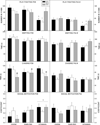Docosahexaenoic acid partially ameliorates deficits in social behavior and ultrasonic vocalizations caused by prenatal ethanol exposure
- PMID: 25746516
- PMCID: PMC4392387
- DOI: 10.1016/j.bbr.2015.02.048
Docosahexaenoic acid partially ameliorates deficits in social behavior and ultrasonic vocalizations caused by prenatal ethanol exposure
Erratum in
-
Corrigendum to "Docosahexaenoic acid partially ameliorates deficits in social behavior and ultrasonic vocalizations caused by prenatal ethanol exposure" [Behav. Brain Res. 286 (2015) 201-211].Behav Brain Res. 2016 Sep 15;311:440. doi: 10.1016/j.bbr.2016.05.054. Epub 2016 May 30. Behav Brain Res. 2016. PMID: 27256320 No abstract available.
Abstract
Prenatal ethanol exposure disrupts social behavior in humans and rodents. One system particularly important for social behavior is the somatosensory system. Prenatal ethanol exposure alters the structure and function of this area. Docosahexaenoic acid (DHA), an omega 3 polyunsaturated fatty acid, is necessary for normal brain development and brains from ethanol-exposed animals are DHA deficient. Thus, we determined whether postnatal DHA supplementation ameliorated behavioral deficits induced by prenatal ethanol exposure. Timed pregnant Long-Evans rats were assigned to one of three groups: ad libitum access to an ethanol-containing liquid diet, pair fed an isocaloric isonutritive non-alcohol liquid diet, or ad libitum access to chow and water. Pups were assigned to one of two postnatal treatment groups; gavaged intragastrically once per day between postnatal day (P)11 and P20 with DHA (10 mg/kg in artificial rat milk) or artificial rat milk. A third group was left untreated. Isolation-induced ultrasonic vocalizations (iUSVs) were recorded on P14. Social behavior and play-induced USVs were tested on P28 or P42. Somatosensory performance was tested with a gap crossing test around P33 or on P42. Anxiety was tested on elevated plus maze around P35. Animals exposed to ethanol prenatally vocalized less, play fought less, and crossed a significantly shorter gap than control-treated animals. Administration of DHA ameliorated these ethanol-induced deficits such that the ethanol-exposed animals given DHA were no longer significantly different to control-treated animals. Thus, DHA administration may have therapeutic value to reverse some of ethanol's damaging effects.
Keywords: DHA; Fetal alcohol syndrome; Omega 3 polyunsaturated fatty acid; Social interaction.
Copyright © 2015 Elsevier B.V. All rights reserved.
Figures






References
-
- Thomas SE, Kelly SJ, Mattson SN, Riley EP. Comparison of social abilities of children with fetal alcohol syndrome to those of children with similar IQ scores and normal controls. Alcohol Clin Exp Res. 1998;22:528–533. - PubMed
-
- Roebuck TM, Mattson SN, Riley EP. Behavioral and psychosocial profiles of alcohol-exposed children. Alcohol Clin Exp Res. 1999;23:1070–1076. - PubMed
-
- Whaley SE, O'Connor And MJ, Gunderson B. Comparison of the adaptive functioning of children prenatally exposed to alcohol to a nonexposed clinical sample. Alcohol Clin Exp Res. 2001;25:1018–1024. - PubMed
-
- Olson HC, Feldman JJ, Streissguth AP, Sampson PD, Bookstein FL. Neuropsychological deficits in adolescents with fetal alcohol syndrome: clinical findings. Alcohol Clin Exp Res. 1998;22:1998–2012. - PubMed
Publication types
MeSH terms
Substances
Grants and funding
LinkOut - more resources
Full Text Sources
Other Literature Sources
Research Materials
Miscellaneous

